Table of contents
It was a simple dish — beans and rice — and, yet, the traditional Costa Rican food welcoming me to Doña Mireya’s kitchen table was one of the best meals I’d eaten abroad. This intimate lunch, lovingly prepared by the matriarch of Santuario Ecológico in Monteverde, introduced me to Costa Rican culture in a way no tour guide ever could.

I don’t blame anyone who seeks out traditional Costa Rican dishes at the country’s amazing restaurants, but it’s important to remember that authentic Costa Rican recipes aren’t kept under lock and key. With the right ingredients, a little time and a passion for savoring the flavors of Tico tradition, you can taste the history and culture of Costa Rica from anywhere in the world. Here are five traditional Costa Rican recipes you can cook right in your kitchen.
#1
Gallo Pinto
Perhaps Costa Rica’s most iconic dish, gallo pinto is rice and dark beans. Translating to “spotted rooster” because of its light and dark colors, this traditional Costa Rican dish is a favorite among Central American locals and tourists alike. You’ll spot gallo pinto on restaurant menus throughout Costa Rica, served for breakfast with accompaniments like eggs, bacon, tortillas, fried plantains, cheese and sour cream.
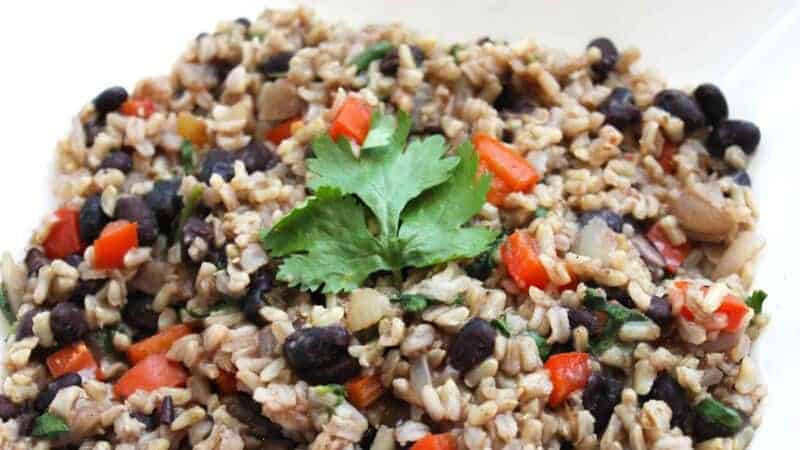
What does gallo pinto have in it?
Gallo pinto is an easy way to introduce a traditional Costa Rican food to your breakfast table. While many Latin American countries have their own variations of the dish, the Costa Rican version usually contains the following ingredients:
- Whiteice (often leftover)
- Black or red beans
- Onions
- Garlic
- Cilantro
- Red pepper
Finally, you’ll want a few teaspoons of Salsa Lizano, a Costa Rican brown sauce similar to Worcestershire sauce. Throw it all in a skillet and within a few minutes, gallo pinto is ready to serve. If you’re staying at one of Special Places’ casas in Playa Potrero, or any of our vacation homes with fully equipped kitchens, you can easily prepare this dish any day. Here’s one recipe for authentic Costa Rican gallo pinto.
#2
Patacones
Whether you’re scanning an appetizer menu or attending one of Costa Rica’s yearly food festivals, you’ll likely come across patacones. Green plantains are cut into thick slices, mashed into a pulp, then fried, creating a tasty treat. Though you can munch on patacones alone, they’re usually served as an appetizer or side dish.
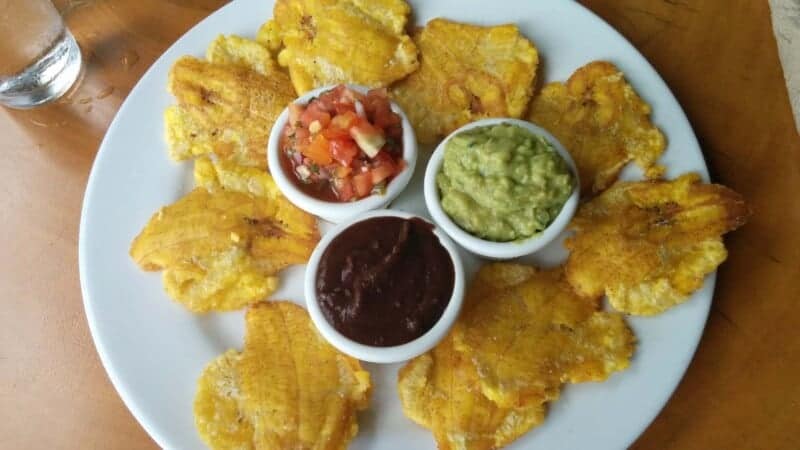
How do you cook patacones?
If you’re searching for a recipe that will please everyone from formal dinner guests to picky children, look no further than patacones. This easy recipe requires only minimal ingredients:
- Green plantains
- Vegetable oil
- Salt
Peel the plantains before cutting them into thick, round slices. Lightly fry them in oil on all sides, then use a tortilla press to smash them into discs. Put them in the oil for one last fry, sprinkle with a little salt, then stand back as your family devours every last one.
Subscribe to our newsletter
to stay up to date
#3
Casado
If you asked a Tico what are the three most popular dishes in Costa Rica, the casado would always make the list. The casado is a full-blown meal that is often a typical lunch in Costa Rican households and restaurants. The word “casado” means “married,” and this hearty meal of meat and vegetables is so called because wives would traditionally pack these lunches in a banana leaf for their husbands to take to work. There are dozens of variations, but you’ll certain say “I do” to casado time and time again.
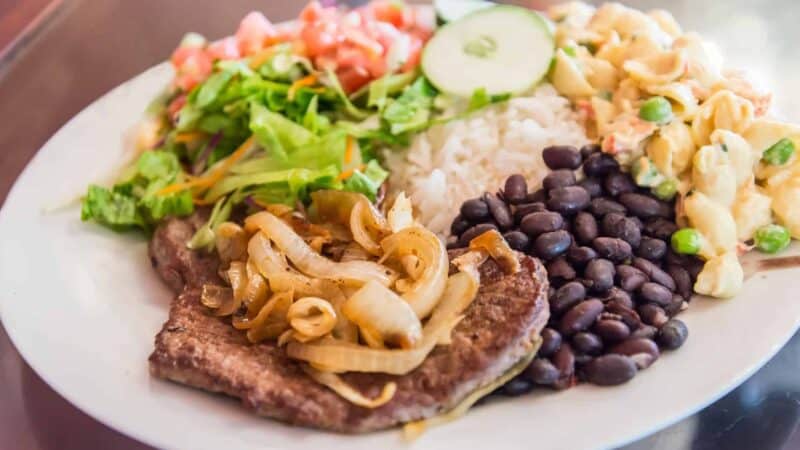
How do you make casado at home?
A casado is a wonderful dish, particularly because it allows you the freedom to express your culinary creativity. The traditional Costa Rican recipes will almost always feature rice, black beans, salad, fried plantains and a meat like chicken, beef, pork or fish. Often they also include patacones, a vegetable hash called picadillo and other sides. Feel free to create your own variation using:
- Fish, pork, chicken or beef
- Mixed greens
- Vegetables like onions or peppers
- Seasoning like black pepper or paprika
- Toppings like sour cream, pico de gallo or avocado
One of the perks of vacationing at one of our Costa Rican condos is that you can find the ingredients for a casado nearby. Head to a market or grocery store and you’ll find most of the ingredients above, as fresh as the Costa Rican breeze.
#4
Chifrijo
Many of the dishes above are meals embraced by other Central and Latin American countries, but chifrijo is 100% authentic Costa Rican food. If gallo pinto is the heart of Costa Rican cuisine, then chifrijo is the soul. At first glance, it’s hard to distinguish what exactly a bowl of chifrijo is. It’s hearty like a dry plate of rice and beans yet brothy like a soup, though neither label fits perfectly. Instead, it’s best to just call this mix of beans, rice, and pork what it truly is: delicious.
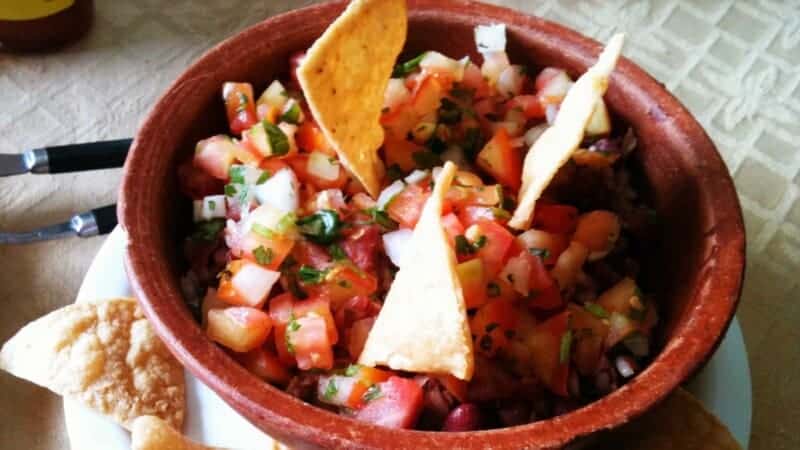
What ingredients are needed to make chifrijo?
Before cooking chifrijo, it’s important to note that this recipe is not as simple as throwing ingredients into a pot and cooking to taste. You’ll need to prepare beans, chimichurri, rice, and fried pork belly separately before combining them for serving. Add these items to your grocery list:
- White rice
- Red or black beans
- Chicharrones (pork rinds)
- Chimichurri ingredients (tomato, onion, cilantro, lime)
- Avocado
- Tortilla chips
Keep in mind that preparing chifrijo is a little more detailed than other authentic Costa Rican dishes. Here is one good chifrijo recipe.

When you’re spending the weekend at one of our Costa Rican beach houses, we recommend opening the windows, turning up your radio, and enjoying an afternoon immersed in the smells, sounds and flavors of the country.
#5
Olla de Carne
Nothing satisfies quite like olla de carne.
This traditional Costa Rican food is a meal that you’ve likely had many times: beef and vegetable stew. Though it sounds simple enough, you haven’t had a beef stew quite like this in North America or Europe. Costa Rica’s regional vegetables make an appearance in this mix, giving the dish a decidedly Central American taste.
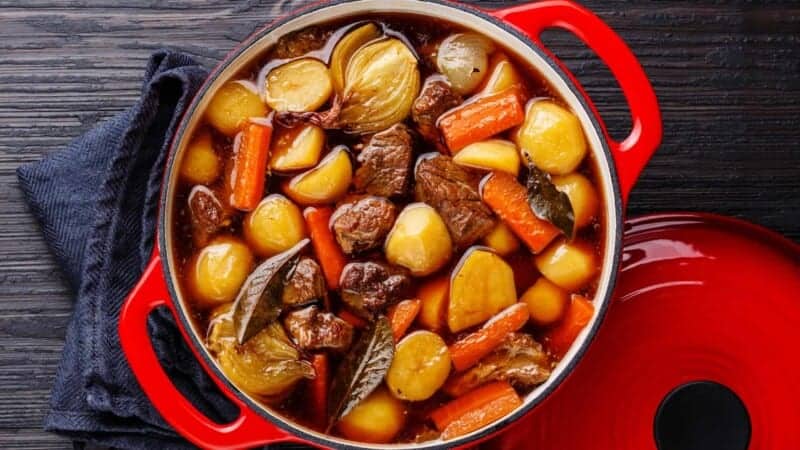
How many ingredients are needed to make olla de carne?
Of the many authentic Costa Rican dishes on this list, olla de carne may feel the most familiar to those residing outside of Costa Rica. Like any homecooked stew, you’ll need the typical staples of meat and potatoes. You’ll also prepare and cook the meal the same way you do any other stew. The Costa Rican twist is found in the regional ingredients mixed in, including:
- Beef
- Potatoes
- Cassava
- Carrots
- Corn
- Taro roots
- Sweet potatoes
- Plantains
Savor the flavors of authentic Costa Rican food right in your kitchen, and share your favorite traditional Costa Rican recipes with your family and friends!
Subscribe to our newsletter
to stay up to date




One Response
On a mission to live to 100!!